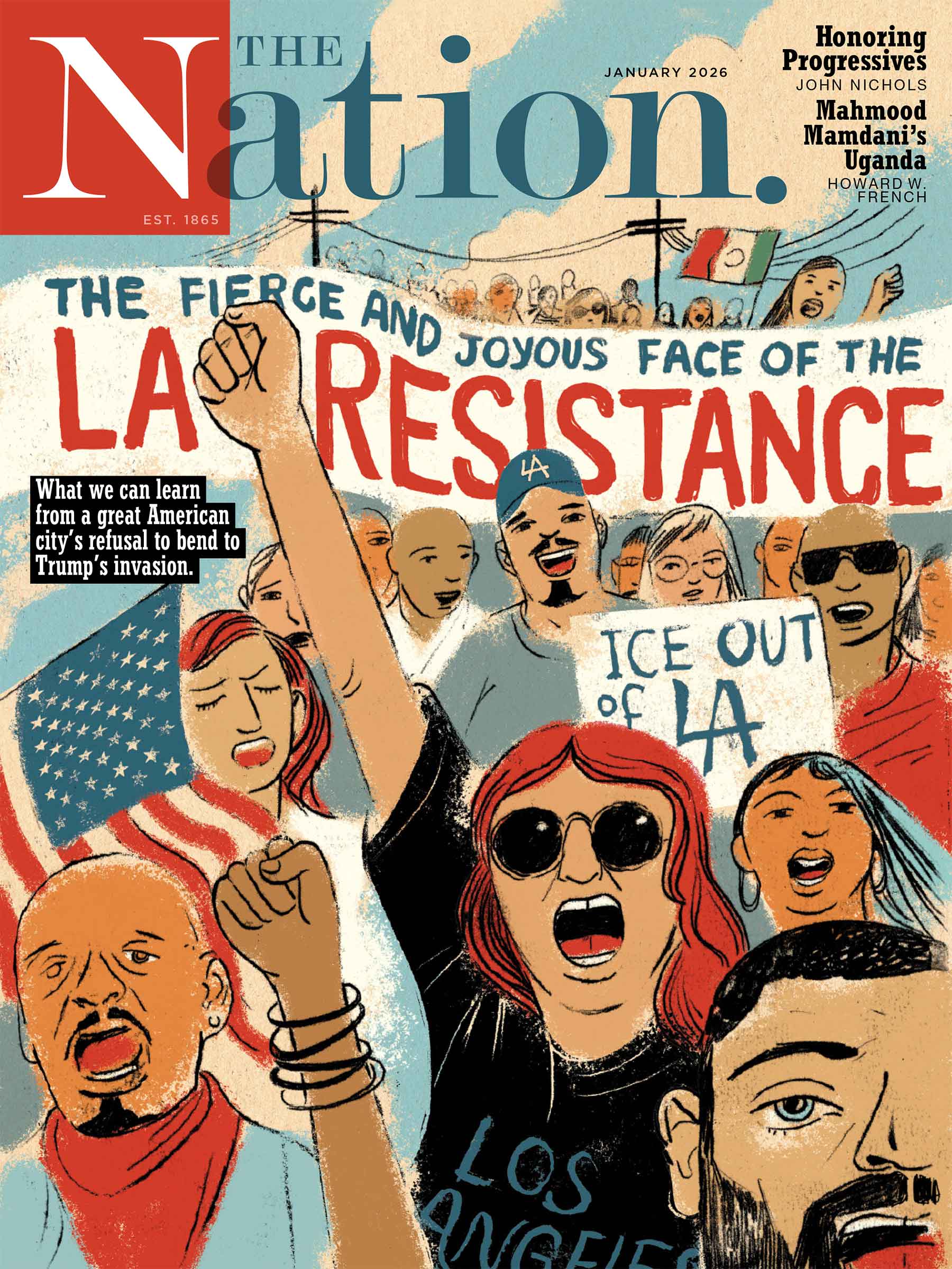A Subtle Power Grab in India
With a constitutional amendment that would transform elections, Narendra Modi wants to realize his vision of a centralized India.
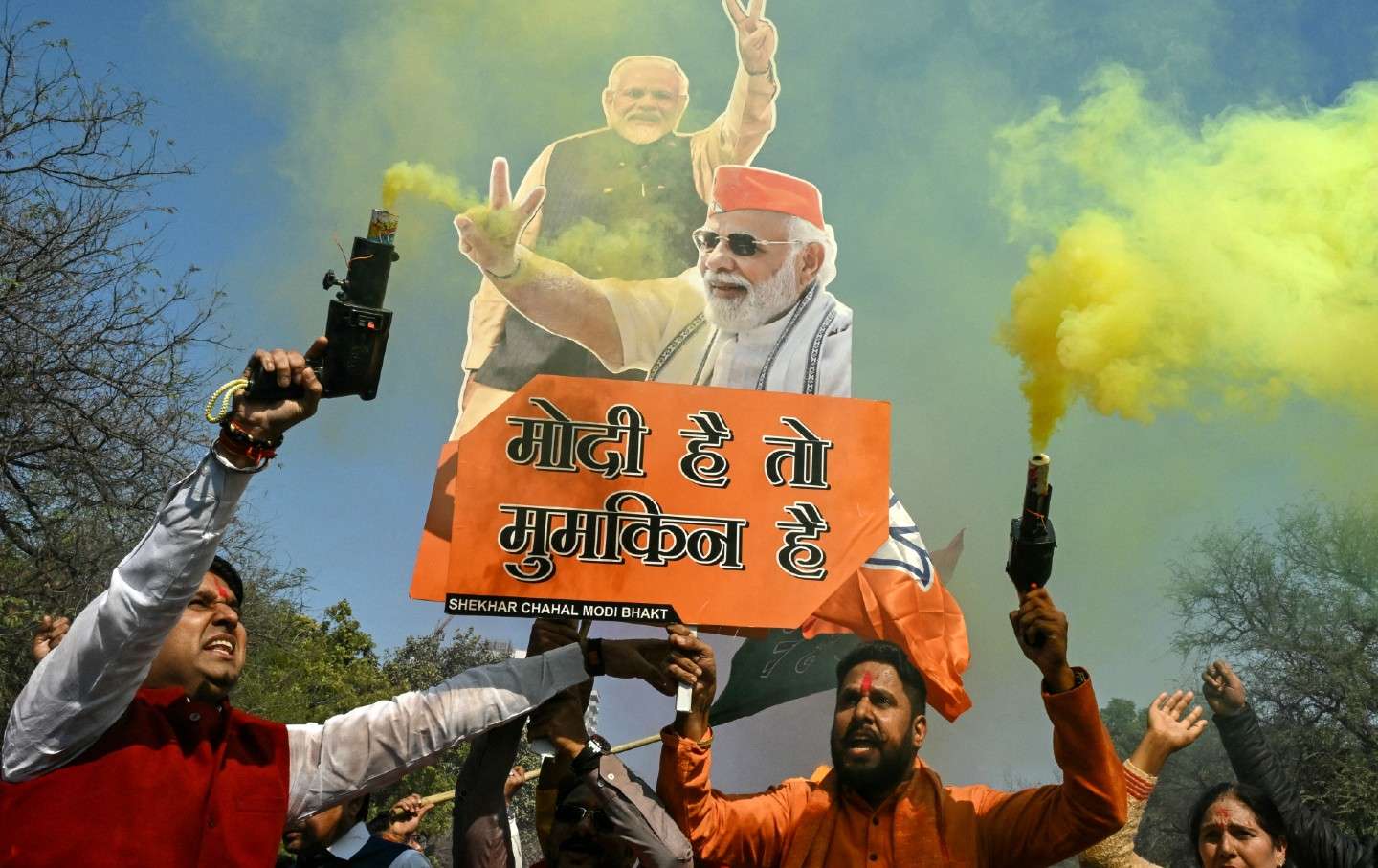
Supporters of the Bharatiya Janata Party (BJP) celebrate as BJP leads in vote counting for the Delhi legislative assembly election outside the party’s state headquarters in New Delhi on February 8, 2025. (Arun Sankar / AFP via Getty Images)
India’s elections, like so much else about the country, operate on a scale that defies comparison. Six hundred and forty-two million people voted in last year’s general elections, delivering a third term for Narendra Modi, the incumbent prime minister, leader of the Hindu-chauvinist Bharatiya Janata Party (BJP), and by far the most consistently popular leader in the democratic world. To accommodate the electorate’s size, voting is staggered over seven “phases,” with one-seventh of the country going to the polls in each phase (the results are released only once everyone has voted). The whole process lasts 44 days.
But even more than federal elections, it is state-level voting that constitutes the true permanent campaign of Indian politics. Take the 2022 elections for the Legislative Assembly of Uttar Pradesh, the world’s most populous subnational province. Ninety-two million people cast their votes, nearly two-thirds as many as voted in the last American presidential election. While the results—victory for Yogi Adityanath, a Modi ally and Hindu-nationalist firebrand—were widely predicted, they were not assured. Thanks in part to the fantastic diversity of India’s political culture, neither “safe” nor “swing” states are a feature of its politics, and opposition parties enthusiastically contest every vote. Multiply this over 36 states and territories, with voters in at least five of them going to the polls in a typical year, and you get a sense of the Indian experience of democracy: vibrant, logistically imposing, peerlessly exorbitant, and essentially continuous.
The constant stream of state votes is a barometer for public feeling toward the sitting national government (imagine midterms in the United States being held 20 times between presidential elections, instead of once). But perhaps more importantly for a country as vast and variegated as India, it also gives hundreds of regional and local parties the chance to connect with their voters in a dedicated forum.
All of this may change, however, if Prime Minister Modi gets his way. At the end of the last legislative session, his government introduced a constitutional amendment that would mandate that all elections—federal, state, and local—be held simultaneously every five years. To move forward, the amendment needs approval from two-thirds of parliament, more than the government currently commands. But Modi and his allies have launched a high-profile campaign pushing the amendment, indicating that they see it as the future and are willing to expend political capital to make it so.
The “One Nation, One Election” proposal, as it’s known, would transform the architecture of Indian politics. No large country with a federalist structure comparable to India’s holds its elections all at once, as Modi is proposing.
The prime minster’s plan has provoked an impassioned response from opposition figures. In the raucous parliamentary debate, lawmakers hectored the government about state autonomy and the limits of federal power. A spokesperson for the Indian National Congress, the country’s main opposition party, went further by calling the plan “a heinous conspiracy to destroy the Constitution.” Dozens more state politicians attacked it on social media. Chief Minister M. K. Stalin of the southern state of Tamil Nadu summed up a common fear by warning, “State elections would lose their political significance and regional sentiments and diversity would be destroyed.”
Remarkably, a number of opposition parliamentarians have even said that the plan would violate the Basic Structure Doctrine, a judicial principle that holds that fundamental aspects of the Constitution—federalism, for example—cannot be amended away. Mentions of the doctrine, a legacy of Indira Gandhi’s 1975–77 period of emergency rule, are relatively rare in Indian political debates, despite their typically hyperbolic atmosphere. To invoke it at all is to imply existential stakes by raising the specter of the only time when Indian democracy came close to extinction.
Such alarmism seems excessive. Synchronizing elections would not change the on-paper power balance between the central government and the states. But the question remains why Modi would attempt a move for which he lacks parliamentary support and which risks enflaming the opposition. In public, he has offered only administrative justifications for the proposed amendment, emphasizing cost savings and the potential for a less disruptive political calendar. He also points out that simultaneous elections were the norm after independence, though he ignores that the number of states (and Indians) was far fewer then.
These statements reveal little about Modi’s intentions. The BJP leader is far from the dictator he is often made out to be in the West, but his Machiavellianism is if anything underrated. Like Franklin Roosevelt, Deng Xiaoping, or Mitch McConnell, Modi is a consummate political animal. Everything he does is carefully calculated for tactical impact, and he is a master of propaganda. It would simply be naïve to think the prime minister would pursue such a major constitutional change for any reason other than the expectation of political gain.
How might that happen? By lining up national and state elections, Modi is likely betting that his personal charisma—or that of whoever succeeds him as BJP leader—can produce a trickle-down effect to box out opposition parties who would otherwise be strong at the state level. Local campaigning by the BJP already follows this model: Posters of the prime minister’s face, often crowned with a different hat depending on local fashions, are omnipresent in India. Modi may also see synchronized elections as a path to wringing more salience out of big cultural issues that are ideologically important to the BJP but make little difference in the life of the average person (things like abolishing constitutional autonomy for the Muslim-majority state of Kashmir, or building a new Hindu temple on the mythical birthplace of the god Ram). In this respect, One Nation, One Election would bring Indian electoral politics closer to those of the United States, where state and local elections have long been overshadowed by national ones.
The most obvious driver of the nationalization of politics in both India and the US is the transformation of the information environment by the Internet. But another factor is the cult status of national political figures. Modi and Donald Trump are often equated as populist strongmen, an analogy that says so little and leaves out so much as to be generally unhelpful. But in this case, the comparison has considerable force.
With a single election inevitably dominated by national narratives, the phenomenon of ticket-splitting (voting for one party nationally and another locally) may be dealt a fatal blow. Right now, ticket-splitting is a small but powerful factor in Indian elections—certainly enough to trouble a popular national government with hegemonic aspirations. The capital of Delhi, for example, has supported the BJP by a landslide in three consecutive national votes; but in between, in 2015 and 2020, it supported the opposition in its own legislative elections by equally large margins. Likewise in the US, ticket-splitting was once common but is now rare, a trend the long-popular Democratic Senators Sherrod Brown and Jon Tester discovered last November.
If down-ballot Republicans benefited from sharing a ticket with Trump as he swept back to power, Modi seems to want to emulate the same model. There is good reason to think he will succeed: In 2024, each of the four states that held an election alongside the national vote saw the same party sweep—and all four were won by the BJP or its allies. If the BJP can keep replicating the national success it has enjoyed over the last decade, it may become more difficult for opposition and regional parties to eke out a foothold in the states.
Modi’s attempts to nationalize Indian politics at the states’ expense should come as no surprise to Indians who daily witness the reach of his cult of personality. Yet there is a profound irony in this kurta-clad, publicly celibate, archconservative leader’s push for centralization. For most of independent India’s early history, it was the Congress Party of India’s first prime minister, Jawaharlal Nehru, that fought for the priority of the national government over the states and regions. The British-educated Nehru believed in a strong state as the only way to enact the program of socialist modernization India needed. So firm were his statist convictions that, in 1947, he preferred to accept the eventual partition of India and Pakistan rather than agree to a system of power-sharing and provincial autonomy that might have prevented it.
Congress-led centralization reached its apotheosis under Nehru’s daughter, Indira Gandhi, until she was toppled in 1977 by a big-tent coalition that included the precursors of the modern BJP. India then entered a long period of political entropy characterized by the rise of minority movements. Regionalist and caste-based parties became a commanding force at the state level, while at the national level coalition governments became the norm. Single-party rule, which Congress had enjoyed for so long under the Nehru-Gandhi dynasty, would not return until Modi.
Popular
“swipe left below to view more authors”Swipe →Today, a depleted Congress Party is in the position of its former rivals, fighting the accumulation of power by a populist prime minister and encouraging regionalism as resistance. And it is the BJP of Narendra Modi that has taken up the cause of centralization—Modi, who, in his combination of demagoguery and genuine popularity, resembles no past leader so much as Indira Gandhi.
The true significance of the amendment may lie in the symbolism of “One Nation” and its relevance to a question Nehru first suggested in 1946: What idea unites the Indian republic? What common ground is there on which to build a modern nation-state in a place with no common language or religion, and which had never been politically unified in its history? India’s first prime minister and its most recent one both made that question central to their premierships, and came up with opposite theories: secular socialism for Nehru, Hindu identity for Modi. But both believed the question demanded a definite answer, and could not be shirked. Neither of them would have accepted the evasion of Akhilesh Yadav, the opposition leader in Uttar Pradesh, who wrote in response to the proposed amendment that the word “one” is inherently antidemocratic because “democracy favors plurality.”
Narendra Modi believes that for, all its diversity, his country is one, not plural—and in this he accords with Nehru, Indira Gandhi, and, perhaps, Donald Trump. With his proposal for unified elections, Modi may come a step closer to bringing that vision of oneness to fruition.
Disobey authoritarians, support The Nation
Over the past year you’ve read Nation writers like Elie Mystal, Kaveh Akbar, John Nichols, Joan Walsh, Bryce Covert, Dave Zirin, Jeet Heer, Michael T. Klare, Katha Pollitt, Amy Littlefield, Gregg Gonsalves, and Sasha Abramsky take on the Trump family’s corruption, set the record straight about Robert F. Kennedy Jr.’s catastrophic Make America Healthy Again movement, survey the fallout and human cost of the DOGE wrecking ball, anticipate the Supreme Court’s dangerous antidemocratic rulings, and amplify successful tactics of resistance on the streets and in Congress.
We publish these stories because when members of our communities are being abducted, household debt is climbing, and AI data centers are causing water and electricity shortages, we have a duty as journalists to do all we can to inform the public.
In 2026, our aim is to do more than ever before—but we need your support to make that happen.
Through December 31, a generous donor will match all donations up to $75,000. That means that your contribution will be doubled, dollar for dollar. If we hit the full match, we’ll be starting 2026 with $150,000 to invest in the stories that impact real people’s lives—the kinds of stories that billionaire-owned, corporate-backed outlets aren’t covering.
With your support, our team will publish major stories that the president and his allies won’t want you to read. We’ll cover the emerging military-tech industrial complex and matters of war, peace, and surveillance, as well as the affordability crisis, hunger, housing, healthcare, the environment, attacks on reproductive rights, and much more. At the same time, we’ll imagine alternatives to Trumpian rule and uplift efforts to create a better world, here and now.
While your gift has twice the impact, I’m asking you to support The Nation with a donation today. You’ll empower the journalists, editors, and fact-checkers best equipped to hold this authoritarian administration to account.
I hope you won’t miss this moment—donate to The Nation today.
Onward,
Katrina vanden Heuvel
Editor and publisher, The Nation
More from The Nation
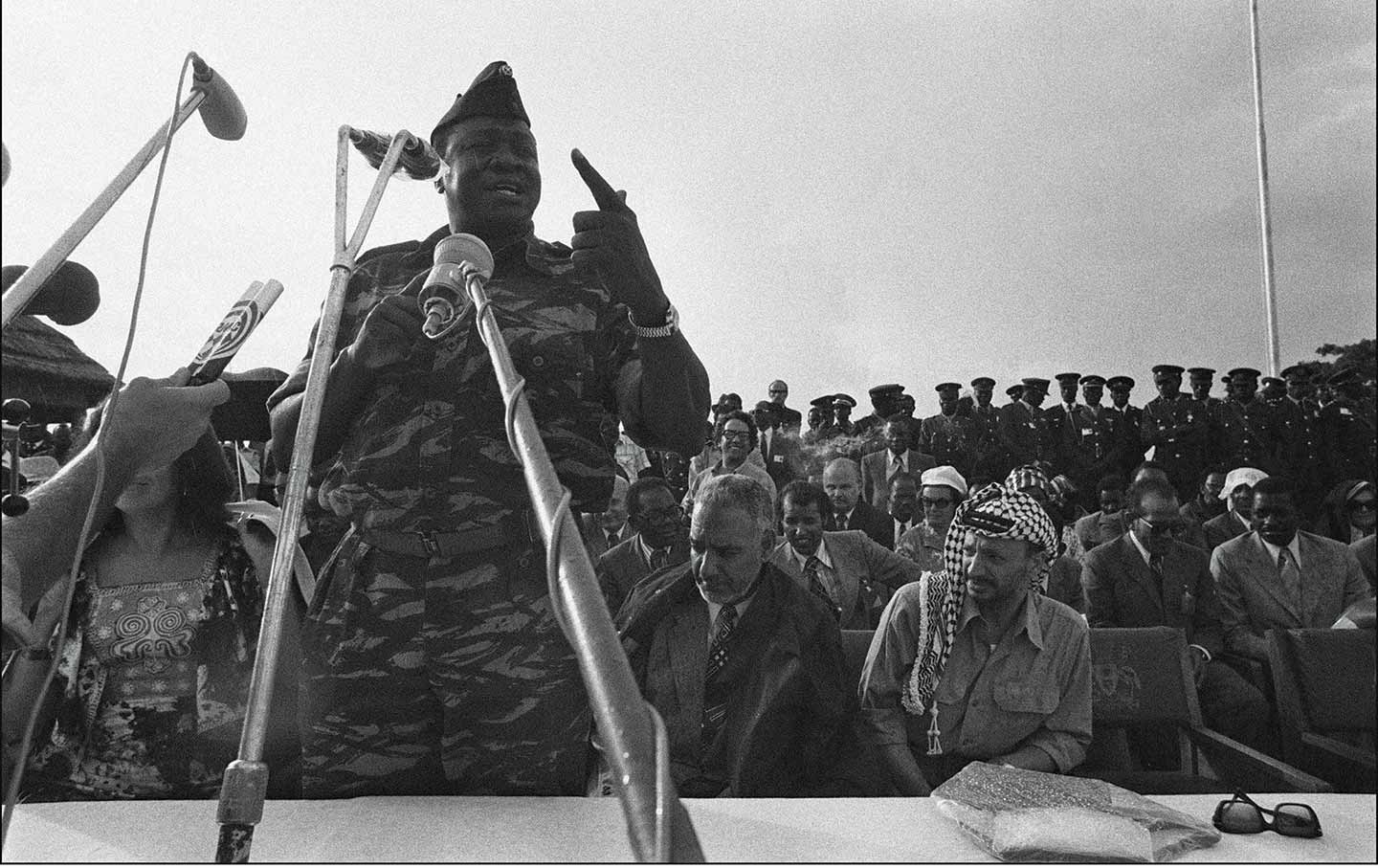
Mahmood Mamdani’s Uganda Mahmood Mamdani’s Uganda
In his new book Slow Poison, the accomplished anthropologist revisits the Idi Amin and Yoweri Museveni years.

The US Is Looking More Like Putin’s Russia Every Day The US Is Looking More Like Putin’s Russia Every Day
We may already be on a superhighway to the sort of class- and race-stratified autocracy that it took Russia so many years to become after the Soviet Union collapsed.

Israel Wants to Destroy My Family's Way of Life. We'll Never Give In. Israel Wants to Destroy My Family's Way of Life. We'll Never Give In.
My family's olive trees have stood in Gaza for decades. Despite genocide, drought, pollution, toxic mines, uprooting, bulldozing, and burning, they're still here—and so are we.
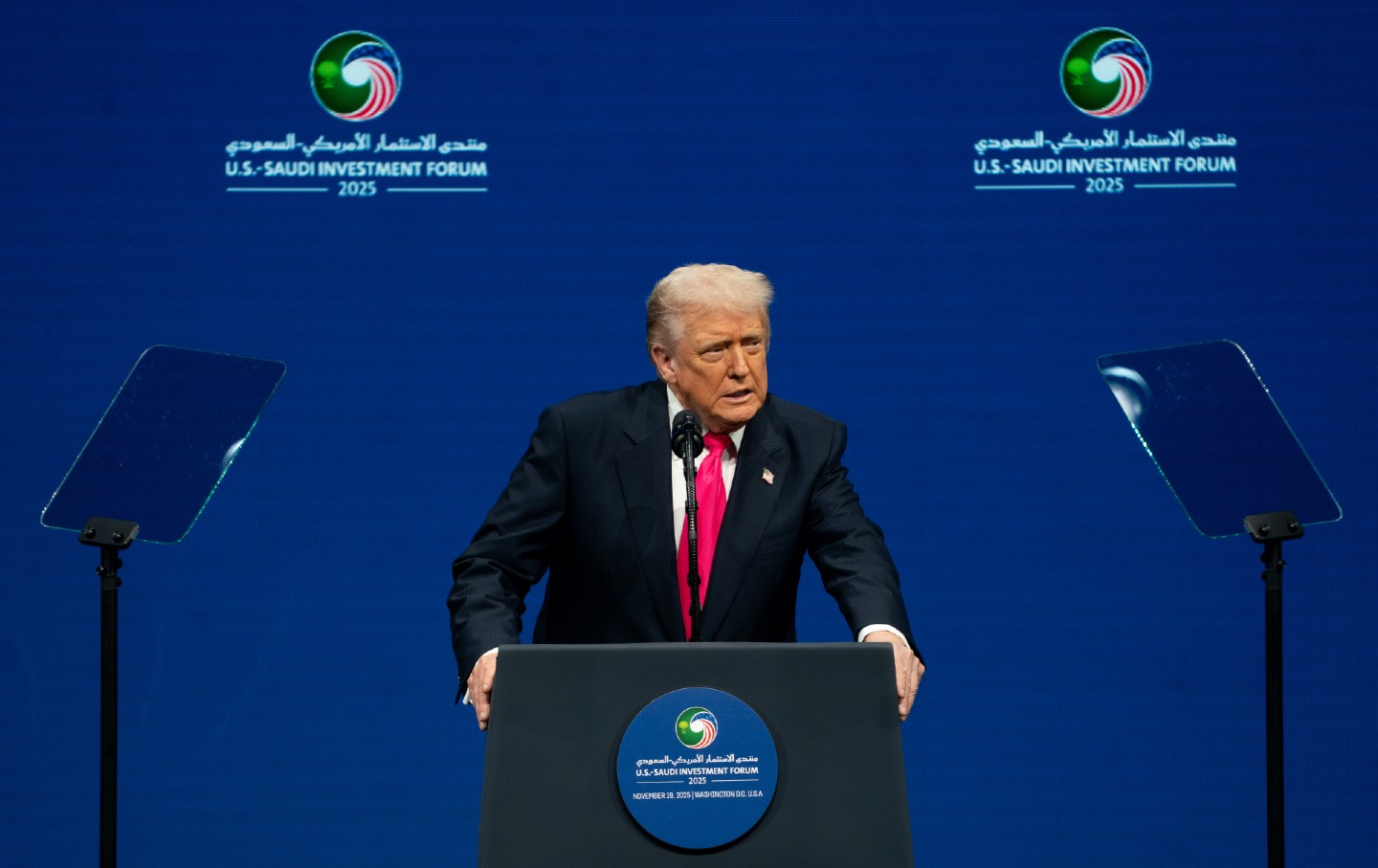
Trump’s National Security Strategy and the Big Con Trump’s National Security Strategy and the Big Con
Sense, nonsense, and lunacy.
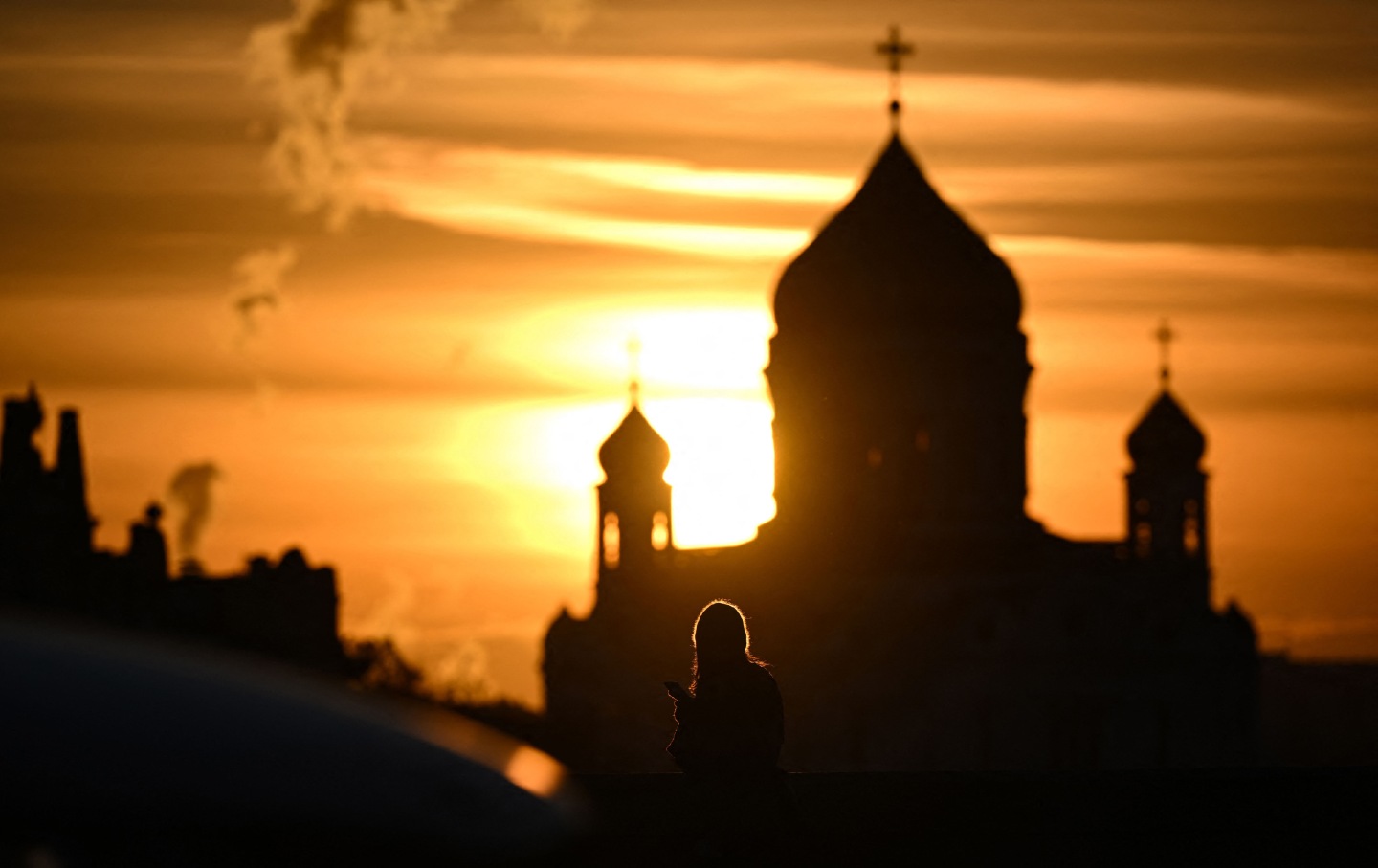
Does Russian Feminism Have a Future? Does Russian Feminism Have a Future?
A Russian feminist reflects on Julia Ioffe’s history of modern Russia.
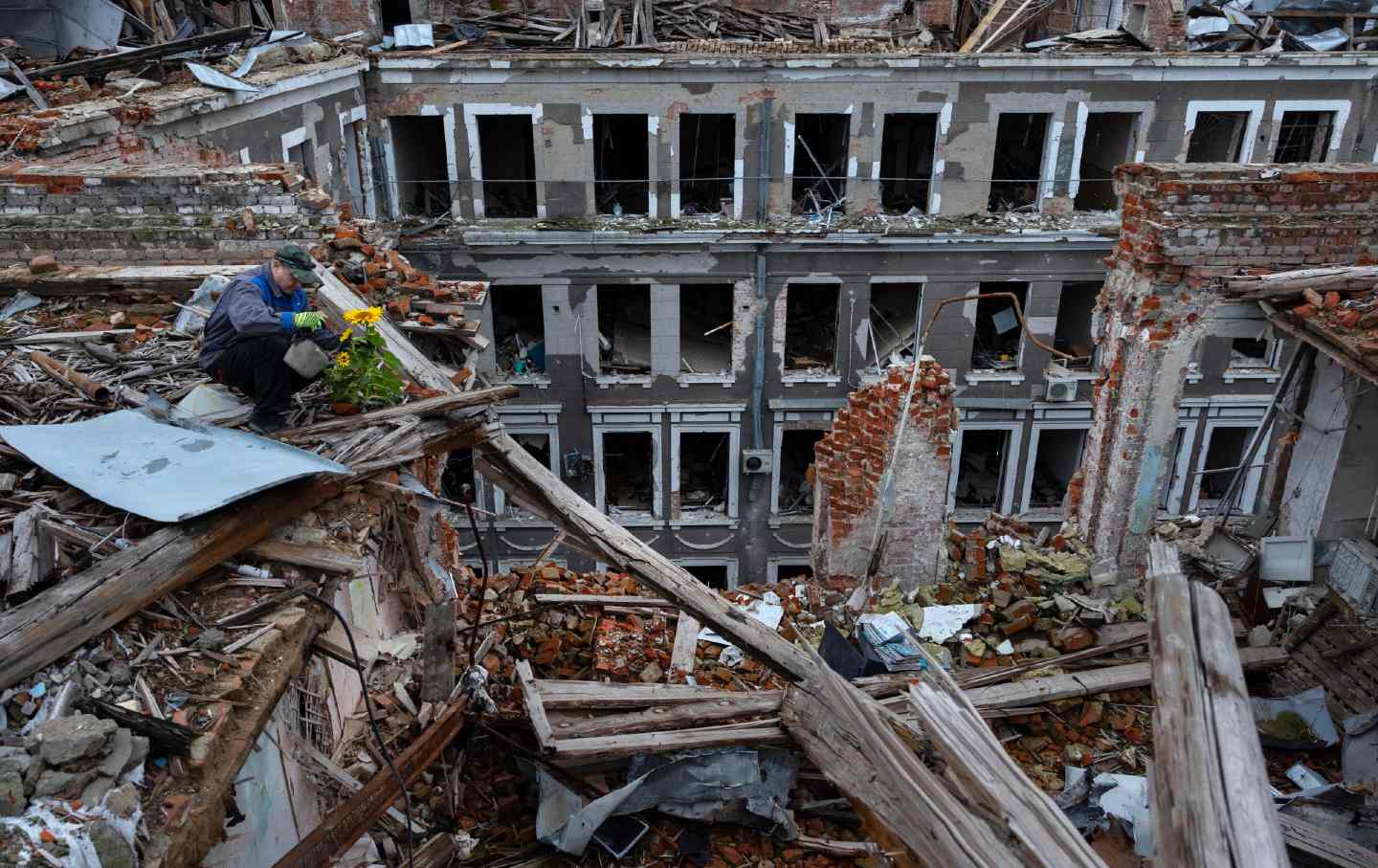
Ukraine’s War on Its Unions Ukraine’s War on Its Unions
Since the start of the war, the Ukrainian government has been cracking down harder on unions and workers’ rights. But slowly, the public mood is shifting.
